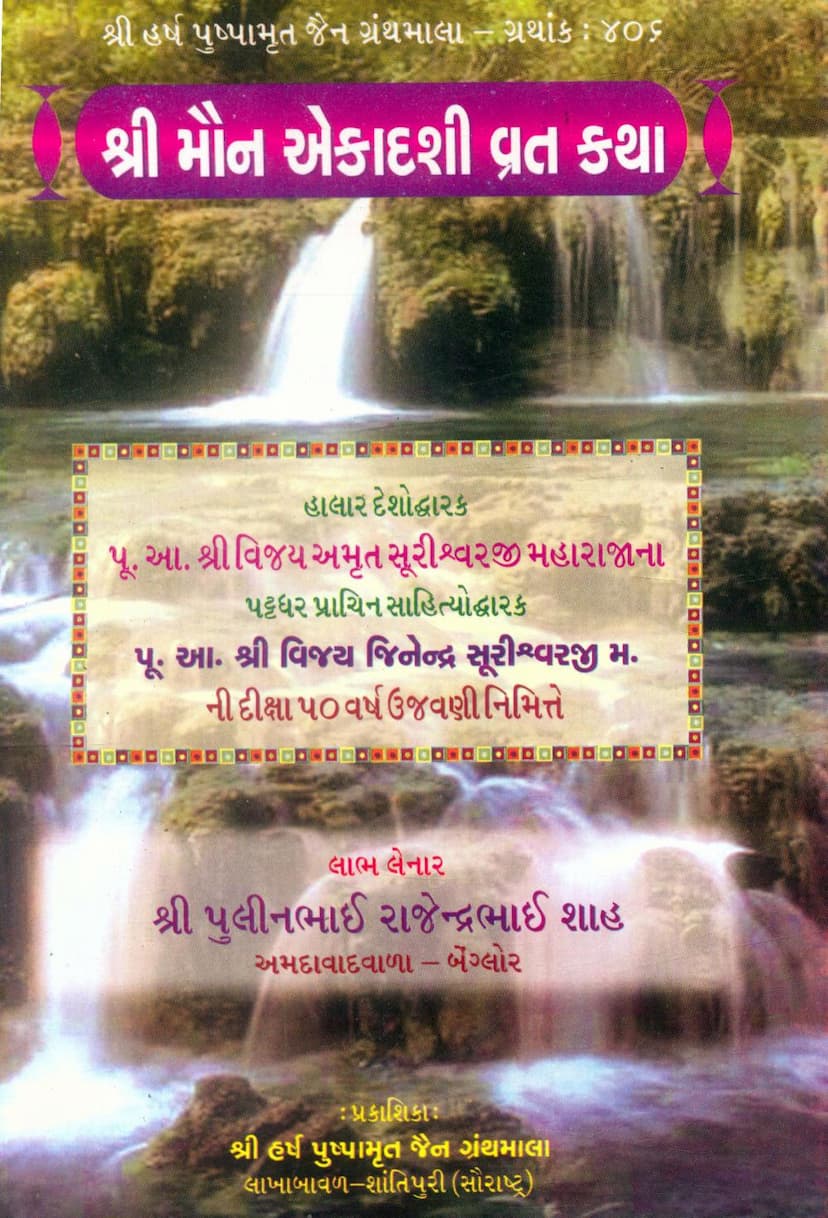Maun Ekadashi Vrat Katha
Added to library: September 2, 2025

Summary
Here's a comprehensive summary of the Jain text "Maun Ekadashi Vrat Katha" by Pulinbhai R Shah:
This book, "Maun Ekadashi Vrat Katha," published by Shri Harsh Pushpamrut Jain Granthmala, is dedicated to celebrating the 50th "Deeksha Golden Jubilee" of Acharya Shri Vijay Jinendrasurishwarji Maharaj. The book itself was compiled by Acharya Shri Vijay Jinendrasurishwarji Maharaj. The publication was sponsored by Shri Pulinbhai Rajendrabhai Shah from Ahmedabad, currently residing in Bangalore. This is the fourth edition, published in 2004.
Core Theme: The central theme of the book is the significance and practice of the "Maun Ekadashi" (Silent Eleventh Day) vrat (vow) in Jainism, particularly on the eleventh day of the waxing moon in the month of Margashirsha (Magshar Sud 11). The narrative emphasizes its immense spiritual benefits, leading to liberation (moksha).
Origin and Significance of Maun Ekadashi: The text explains that when questioned by Gautam Swami about the benefits of observing the Poushadh (a day of fasting and religious observance) on Margashirsha Shukla Ekadashi, Lord Mahavir explained its great significance. He mentioned that Lord Neminath himself advised King Krishna that if one cannot observe dharma continuously, this specific day offers substantial merit for even minimal religious effort.
The Margashirsha Sud 11 is considered the most auspicious day because:
- In this Bharata area, the 18th Tirthankar, Shri Adinathji, took initiation on this day.
- The 21st Tirthankar, Shri Neminathji, attained Kevalgnan (omniscience) on this day.
- The 19th Tirthankar, Shri Mallinathji, had their birth and initiation on this day, and also attained Kevalgnan.
- Thus, five Kalyanakas (auspicious events in a Tirthankar's life) occurred in this specific area and period.
- Across all five Bharata and five Airavat regions, and considering past, present, and future Tirthankaras, a total of 150 Kalyanakas occurred on this specific day. Therefore, observing one day of fasting on this Ekadashi is equivalent to 150 days of fasting.
Practices of Maun Ekadashi: The vrat involves:
- Observing silence (Maun): Renouncing worldly activities and speaking only when necessary, with proper intention.
- Chauvihar Poushadh: Fasting from all four types of consumables (food, water, edibles, and chewables) from sunrise to sunrise (eight prahars).
- Focus on Dharma: Engaging in religious contemplation, listening to religious discourses, discussing dharma, studying scriptures, and singing devotional songs. It is emphasized that such religious activities do not break the silence vow.
- Avoiding sinful speech: Refraining from speaking detrimental words or engaging in idle gossip (vikatha).
- After the fast (Parana): Worshipping the scriptures, visiting the temple, offering prayers and fruits to the Jin idols, offering food to Sadhus (monks), and then breaking the fast.
- Duration: This vrat is to be observed for eleven years.
- Ujmana (Celebration at completion): At the end of eleven years, a special celebration (Ujmana) is performed, including offering eleven types of sweets, fruits, and grains to the Jin idols, feeding eleven monks or lay followers (Shravaks), and performing other acts of devotion to the Sangh (community).
The Story of Suvrat Seth: The Katha then narrates the story of Suvrat Seth from Vijaypur.
- Past Life: Suvrat Seth, in a previous life, was a merchant named Soor. He learned about the Maun Ekadashi vrat from his Guru and observed it with his family for eleven years. Due to the merit of this tapasya, he was reborn as a divine being in the Aranya Devaloka for twenty-one sagaropama years.
- Present Life: After exhausting his divine merits, he was reborn as the son of Seth Samudradatta and Pritimati in Sauripur. He was named Suvrat. He learned all the arts and sciences and married eleven daughters of wealthy merchants. He lived a prosperous life, managed his father's business, and his father eventually attained liberation.
- Spiritual Awakening: During a discourse by Acharya Shilsundar, Suvrat Seth heard about the Margashirsha Shukla Ekadashi and, through his past life's recollection (jati smaran), remembered his previous virtuous life. He then took the vow of Maun Ekadashi again with his family.
- Miracles during the Vrat:
- During one observance, thieves entered his house to steal, but the guardian deities (Shasan Devta) kept them frozen until morning due to the merit of Suvrat's vrat.
- On another occasion, a massive fire broke out in the city. While the rest of the city was consumed by flames, Suvrat's house, possessions, and religious buildings were miraculously protected, highlighting the power of his devotion.
- Renunciation and Liberation: After completing his worldly duties and observing the Maun Ekadashi vrat, Suvrat Seth decided to renounce the world. He took initiation from Acharya Gun Sundar, the owner of four types of control (shaan). He diligently practiced severe austerities, including fasts of various durations.
- Attaining Kevalgnan: During one Maun Ekadashi, while in contemplation, a malevolent demi-god (vyantar devta) entered a fellow monk and induced unbearable pain. This monk, driven by the pain, struck Suvrat Muni. Instead of getting angry, Suvrat Muni experienced profound compassion for the suffering monk and contemplated how he could help. This deep contemplation led him to attain Shukl Dhyan and ultimately Kevalgnan (omniscience).
- Final Liberation: After attaining Kevalgnan, Suvrat Muni preached dharma for many years and finally attained liberation (Moksha) by performing a final fast.
Conclusion: The story of Suvrat Seth serves as a powerful example of the benefits derived from observing the Maun Ekadashi vrat. It highlights how such devotion can lead to miraculous protection, immense spiritual merit, and ultimately, liberation from the cycle of birth and death. Lord Krishna, upon hearing this from Lord Neminath, became more devoted to dharma and earned Tirthankar Gotra karma. Lord Mahavir recounted this story to Gautam Ganadhar, inspiring many to undertake the Maun Ekadashi vrat.